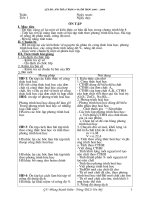Gián án Chapter 9 Chemical Bonding I:Lewis Theory
Bạn đang xem bản rút gọn của tài liệu. Xem và tải ngay bản đầy đủ của tài liệu tại đây (3.28 MB, 91 trang )
Chapter 9
Chemical
Bonding I:
Lewis Theory
2011, NKMB Co., Ltd.
Chemistry, Julia Burdge, 2
st
Ed.
McGraw Hill.
Mr. Truong Minh Chien ;
/>
2
Bonding Theories
•
explain how and why atoms attach together
•
explain why some combinations of atoms are stable and
others are not
why is water H
2
O, not HO or H
5
O
•
one of the simplest bonding theories was developed by
G.N. Lewis and is called Lewis Theory
•
Lewis Theory emphasizes valence electrons to explain
bonding
•
using Lewis Theory, we can draw models – called
Lewis structures – that allow us to predict many
properties of molecules
aka Electron Dot Structures
such as molecular shape, size, polarity
Chemistry, Julia Burdge, 2
nd
e., McGraw Hill.
3
Why Do Atoms Bond?
•
processes are spontaneous if they result in a system with
lower potential energy
•
chemical bonds form because they lower the potential
energy between the charged particles that compose
atoms
•
the potential energy between charged particles is directly
proportional to the product of the charges
•
the potential energy between charged particles is
inversely proportional to the distance between the
charges
Chemistry, Julia Burdge, 2
nd
e., McGraw Hill.
4
Potential Energy Between
Charged Particles
∀
∈
0
is a constant
= 8.85 x 10
-12
C
2
/J∙m
•
for charges with the same sign, E
potential
is + and the
magnitude gets less positive as the particles get farther
apart
•
for charges with the opposite signs, E
potential
is − and the
magnitude gets more negative as the particles get closer
together
•
remember: the more negative the potential energy, the
more stable the system becomes
•
∈
=
r
21
0
potential
4
1
E
π
Chemistry, Julia Burdge, 2
nd
e., McGraw Hill.
5
Potential Energy Between
Charged Particles
The repulsion between
like-charged particles
increases as the
particles get closer
together. To bring
them closer requires the
addition of more
energy.
The attraction between
opposite-charged
particles increases as
the particles get closer
together. Bringing
them closer lowers the
potential energy of the
system.
Chemistry, Julia Burdge, 2
nd
e., McGraw Hill.
6
Bonding
•
a chemical bond forms when the potential
energy of the bonded atoms is less than the
potential energy of the separate atoms
•
have to consider following interactions:
nucleus-to-nucleus repulsion
electron-to-electron repulsion
nucleus-to-electron attraction
Chemistry, Julia Burdge, 2
nd
e., McGraw Hill.
Tro, Chemistry: A Molecular Approach 7
Types of Bonds
Types of Atoms Type of Bond
Bond
Characteristic
metals to
nonmetals
Ionic
electrons
transferred
nonmetals to
nonmetals
Covalent
electrons
shared
metal to
metal
Metallic
electrons
pooled
8
Types of Bonding
Tro, Chemistry: A Molecular Approach 9
Ionic Bonds
•
when metals bond to nonmetals, some electrons
from the metal atoms are transferred to the
nonmetal atoms
metals have low ionization energy, relatively easy to
remove an electron from
nonmetals have high electron affinities, relatively
good to add electrons to
Tro, Chemistry: A Molecular Approach 10
Covalent Bonds
•
nonmetals have relatively high ionization energies, so it
is difficult to remove electrons from them
•
when nonmetals bond together, it is better in terms of
potential energy for the atoms to share valence electrons
potential energy lowest when the electrons are between the
nuclei
•
shared electrons hold the atoms together by attracting
nuclei of both atoms
Tro, Chemistry: A Molecular Approach 11
Determining the Number of Valence
Electrons in an Atom
•
the column number on the Periodic Table will tell you
how many valence electrons a main group atom has
Transition Elements all have 2 valence electrons; Why?
1A 2A 3A 4A 5A 6A 7A 8A
Li Be B C N O F Ne
1 e
-1
2 e
-1
3 e
-1
4 e
-1
5 e
-1
6 e
-1
7 e
-1
8 e
-1
Tro, Chemistry: A Molecular Approach 12
Lewis Symbols of Atoms
•
aka electron dot symbols
•
use symbol of element to represent nucleus and
inner electrons
•
use dots around the symbol to represent valence
electrons
pair first two electrons for the s orbital
put one electron on each open side for p electrons
then pair rest of the p electrons
•
Li
•
•
Be
•
•
•
B
•
•
•
•
C
•
•
•
•
•
N
••
•
•
•
•
O
••
•
•
•
•
•
F
••
•
•
•
•
••
Ne
Tro, Chemistry: A Molecular Approach 13
Lewis Symbols of Ions
•
Cations have Lewis symbols without
valence electrons
Lost in the cation formation
•
Anions have Lewis symbols with 8 valence
electrons
Electrons gained in the formation of the anion
Li• Li
+1
••
•
•
•
•
•
F
1
F
−
••
•
•
•
•
••
Tro, Chemistry: A Molecular Approach 15
Stable Electron Arrangements
And Ion Charge
•
Metals form cations by losing
enough electrons to get the
same electron configuration
as the previous noble gas
•
Nonmetals form anions by
gaining enough electrons to
get the same electron
configuration as the next
noble gas
•
The noble gas electron
configuration must be very
stable
Tro, Chemistry: A Molecular Approach 16
Octet Rule
•
when atoms bond, they tend to gain, lose, or share electrons to
result in 8 valence electrons
•
ns
2
np
6
noble gas configuration
•
many exceptions
H, Li, Be, B attain an electron configuration like He
He = 2 valence electrons
Li loses its one valence electron
H shares or gains one electron
though it commonly loses its one electron to become H
+
Be loses 2 electrons to become Be
2+
though it commonly shares its two electrons in covalent bonds, resulting in 4
valence electrons
B loses 3 electrons to become B
3+
though it commonly shares its three electrons in covalent bonds, resulting in 6
valence electrons
expanded octets for elements in Period 3 or below
using empty valence d orbitals
Tro, Chemistry: A Molecular Approach 17
Lewis Theory
•
the basis of Lewis Theory is that there are
certain electron arrangements in the atom that
are more stable
octet rule
•
bonding occurs so atoms attain a more stable
electron configuration
more stable = lower potential energy
no attempt to quantify the energy as the calculation is
extremely complex
Tro, Chemistry: A Molecular Approach 18
Properties of Ionic Compounds
•
hard and brittle crystalline solids
all are solids at room temperature
•
melting points generally > 300°C
•
the liquid state conducts electricity
the solid state does not conduct electricity
•
many are soluble in water
the solution conducts electricity well
Melting an Ionic Solid
Tro, Chemistry: A Molecular Approach 19
Conductivity of NaCl
in NaCl(s), the
ions are stuck in
position and not
allowed to move
to the charged
rods
in NaCl(aq), the
ions are
separated and
allowed to move
to the charged
rods
Tro, Chemistry: A Molecular Approach 20
Lewis Theory and Ionic Bonding
•
Lewis symbols can be used to represent the
transfer of electrons from metal atom to
nonmetal atom, resulting in ions that are
attracted to each other and therefore bond
••
•
•
•
•
•
F
•
Li
+
1
F
−
••
•
•
•
•
••
Li
+
Tro, Chemistry: A Molecular Approach 21
Predicting Ionic Formulas
Using Lewis Symbols
•
electrons are transferred until the metal loses all its
valence electrons and the nonmetal has an octet
•
numbers of atoms are adjusted so the electron transfer
comes out even
••
•
•
•
•
O
•
Li
•
Li
−
••
•
•
•
•
••
2
O
2 Li
+
Li
2
O
Tro, Chemistry: A Molecular Approach 22
Energetics of Ionic Bond Formation
•
the ionization energy of the metal is endothermic
Na(s) → Na
+
(g) + 1 e
─
∆H° = +496 kJ/mol
•
the electron affinity of the nonmetal is exothermic
Cl(g) + 1 e
─
→ Cl
─
(g) ∆H° = ─ 349 kJ/mol
•
generally, the ionization energy of the metal is larger
than the electron affinity of the nonmetal, therefore the
formation of ionic molecules is endothermic.
Na(s) + ½Cl
2
(g) → NaCl(s) ∆H°
f
= +147 kJ/mol
•
However, the heat of formation of most ionic
compounds is exothermic and generally large; Why?
Tro, Chemistry: A Molecular Approach 23
Ionic Bonds
•
electrostatic attraction!!
no direct anion-cation pair
•
ions arranged in a pattern called a crystal lattice
every cation surrounded by anions; and every anion
surrounded by cations
maximizes attractions between + and - ions
Lattice Energy
•
the lattice energy is the energy released when the solid
crystal forms from separate ions in the gas state
always exothermic
hard to measure directly, but can be calculated from
knowledge of other processes
•
lattice energy depends directly on size of charges and
inversely on distance between ions
For NaCl the energy
of forming a crystal
lattice is -787 kJ/mol
•
∈
=
r
21
0
potential
4
1
E
π
Tro, Chemistry: A Molecular Approach 25
Born-Haber Cycle
•
method for determining the lattice energy of an
ionic substance by using other reactions
use Hess’s Law to add up heats of other processes
•
∆H°
f
(salt) = ∆H°
f
(metal atoms, g) + ∆H°
f
(nonmetal atoms, g) +
∆H°
f
(cations, g) + ∆H°
f
(anions, g) + ∆H°
f
(crystal lattice)
∆H°
f
(crystal lattice) = Lattice Energy
metal atoms (g) → cations (g), ∆H°
f
= ionization energy
don’t forget to add together all the ionization energies to get to the
desired cation
M
2+
= 1
st
IE + 2
nd
IE
nonmetal atoms (g) → anions (g), ∆H°
f
= electron affinity
26
Born-Haber Cycle for NaCl
Na(s) → Na
+
(g) + 1 e
─
∆H° = +496 kJ/mol
Cl(g) + 1 e
─
→ Cl
─
(g) ∆H° = ─ 349 kJ/mol
Na(s) + ½Cl
2
(g) → NaCl(s) ∆H°
f
= +147 kJ/mol
NaCl the energy
of forming a crystal
lattice is -787 kJ/mol









